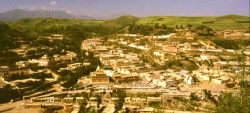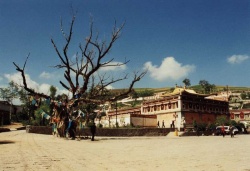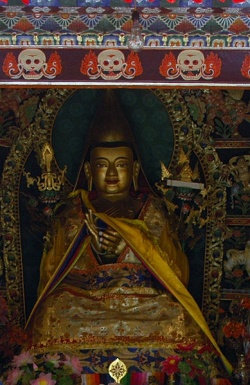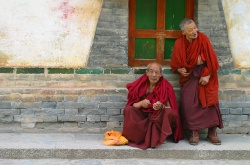Kumbum Monastery
Kumbum Monastery (Standard Tibetan: སྐུ་འབུམ་བྱམས་པ་གླིང།, Wylie: sKu-'bum Byams-pa gling; also known as Ta'ersi, Chinese: 塔尔寺) is a Buddhist Monastery in Qinghai province, China. Kumbum was founded in 1583 in a narrow valley close to the village of Lusar in the Tibetan cultural region of Amdo. Its superior Monastery is Drepung, immediately to the west of Lhasa. It was ranked in importance as second only to Lhasa.
Description
Alexandra David-Neel, the famous Belgian-French explorer who spent more than two years studying and translating Tibetan Books at the Monastery, said of it that "the configuration of the surrounding mountain ranges arrested the passage of the clouds, and forced them to turn around the rocky summit which supported the gompa forming a sea of white mist, with its waves beating silently against the cells of the Monks, wreathing the wooded slopes and creating a thousand fanciful landscapes as they rolled by. Terrible hailstorms would often break over the Monastery, due, said The country folk, to the malignity of the demons who sought to disturb the Peace of the saintly Monks."
- We were taken first to the great kitchen where priests were brewing Tibetan tea in great copper cauldrons ten feet in diameter, beautifully chased with the Buddhist Symbols. The stoves were the usual mud affairs and the fuel nothing but straw, which younger lamas continually fed to the Fire."
Origins: The Tree of Great Merit
Tsongkhapa, the founder of the Gelugpa (Yellow Hat) sect of Tibetan Buddhism, was born nearby in 1357. According to one tradition, Tsongkhapa's father took the afterbirth and buried it here, and soon a sandalwood Tree grew on the spot. Another version has it that the Tree grew up where drops of blood from Tsongkhapa's umbilical cord had fallen on the ground. In any case this Tree became known as the "Tree of Great Merit." The leaves and the bark of this Tree were reputed to bear impressions of The Buddha's face and various mystic syllables and its blossoms were said to give off a peculiarly pleasing scent.
The four-storied golden-roofed temple built around the Tree where Tsongkhapa is said to have been born is called Serdong or 'Golden Tree' and is considered the holiest place in Kumbum.
- "On the porch of the Golden Temple, pilgrims prostrate themselves one hundred Times and the boards are worn into grooves where their feet and hands touch. . . . We were taken into one great temple capable of seating twenty-five hundred priests. The great pillars were covered with brilliantly woven rugs, skins of Animals, and the bright "pulo" cloth of the Tibetans. It was a mass of brilliant, garish colors and to my Mind would have been wonderful in a more subdued Light."
Two Catholic missionaries, Évariste Régis Huc and Joseph Gabet who arrived here in the 1840s when the Tree was still living were fully prepared to dismiss "The Tree of Great Merit" as just another fanciful legend. "We were filled with an absolute consternation of astonishment," Huc noted in his famous book Travels in Tartary, "at finding that, in point of fact, there were upon each of the leaves well-formed Tibetan characters . . . Our first impression was a suspicion of fraud on the part of the lamas; but after a minute examination of every detail, we could not discover the least deception." Section of this Tree are now preserved in a Stupa in the Great Golden Temple ."
The "Golden Tiled Temple"
- "The "Golden Tiled Temple" is revered throughout Tibet and Mongolia. It is a small building with a roof of pure gold plate. Inside, it is full of wonderful Relics, great banners of silk brocade called "katas" (Khatag), wonderful lamps of gold and silver, thousands of small vessels burning butter, a colossal figure of Tsong Kapa, said to be made of gold. All is in semi-darkness which adds to the Mystical effect, and the gleam from the butter lamps threw into relief some beautifully wrought temple vessels, or the queer blank face of some saintly Buddha image."
History
Foundation
In the 1360s Tsongkhapa's mother, with the help of locals, had a small temple with a Stupa built on the site of his birthplace.
In 1560 the meditator Rinchen-tsondru-gyeltsen (Rin-chen brtson-'grus rgyal-mtshan) built a small Monastery there, called Gonpalung, for intensive Meditation practice. At first, it had seven Monks at a Time, but soon expanded to hold fifteen.
In 1576, Altan Khan (1507–1583) of the Tumed Mongols invited the future Third Dalai Lama, Sonam-gyatso, to bring Buddhism to Mongolia. After Altan Khan adopted Buddhism, he gave him the title Dalai Lama. "Dalai" is the Mongolian translation of "gyatso," meaning "ocean.".
On his Way to meet Altan Khan near Kokonor, the 3rd Dalai Lama (1543–1588) stopped at the isolated Retreat by the holy Tree marking the spot where Tsongkhapa had been born. He requested Rinchen-tsondru-gyeltsen to construct a larger Monastery at this site and appointed him as the head Lama. The Monastery was built completely in 1583 and a fence was erected around the "Tree of Great Merit". An annual Prayer Festival (sMon-lam) was inaugurated, like the one held in Lhasa.
The new Monastery was called Kumbum Jampa-ling. "Kumbum" means "100,000 enlightening bodies of The Buddha". It is named after the 100,000 images of The Buddha Sinhanada which appear on the leaves of the holy sandalwood Tree. "Jampa-ling" means "Maitreya Cloister." This refers to the Maitreya temple built by Rinchen-tsondru-gyeltsen to the Right of the precious Tree.
The First Throne Holder of Kumbum was Duldzin Ozer-gyatso ('Dul-'dzin 'Od-zer rgya-mtsho), born in 1557. In 1603, the Fourth Dalai Lama, Yonten Gyatso (1589–1616), stopped at Kumbum on his Way from his native Mongolia to Central Tibet. At that Time, he proclaimed the need for a study division to be built and for Duldzin Ozer-gyatso to be appointed as the head of the entire Monastery. At Kumbum's Monlam Prayer Festival of 1612, Duldzin Ozer-gyatso first ascended to the throne of Abbot and opened the Debate College, Pelden Shaydrubling Dratsang (dPal-ldan bShad-grub gling Grva-tshang).
By the middle of the 20th century, Kumbum Monastery included thirty temples and a thousand or so houses.
The Chinese Muslim General Ma Bufang patronized the 10th Panchen Lama, and the Lamaist Red Sect against the Dalai Lama. Qinghai served as a "Sanctuary" for Red Sect members, Ma Bufang allowed Kumbum Monastery to be totally Self-governed by the Panchen Lama.
Monastic colleges
Kumbum has four monastic colleges or faculties (dratsang). The largest is the Debate College or Faculty for Logic, the Shadupling Dratsang. Most of its divisions use the textbooks of Jetsunpa Chokyi-gyeltsen (1469–1544), as at Ganden Jangtsey and Sera Jey Colleges near Lhasa. A few of the divisions follow the textbooks of Kunkyen Jamyang-zhaypa Ngawang-tsondru (1648–1722), as at Gomang College of Drepung Monastery and Labrang Monastery. The highest degrees of Geshe Rabjampa and Geshe Shayrampa are awarded at the Kumbum Monlam Prayer Festival each year.
Gyüpa Dratsang, the Tantric College, or Sangngag Dechenling Datsang was founded by Chojey Legpa-gyatso in 1649. The curriculum follows that of Gyumay Lower Tantric College of Lhasa. After study of the major texts and commentaries of the Guhyasamaja, Chakrasamvara (bDe-mchog), and Vajrabhairava, Monks receive the Geshe Ngagrampa degree.
In 1711, Chuzang Lozang-tenpay-gyeltsen built a new Tantric College, Ngagpa Dratsang. In 1723, the combined Manchu and Chinese armies severely damaged the four great Monasteries of the Kokonor region – Kumbum, Gonlung, Serkog and Chuzang and many Monks fled. Soon afterwards, the Manchu commander asked the Twenty-first Throne Holder to convert the new Ngagpa Dratsang into a Medical College, and this was done. With the appointment of several famous Doctors, the Medical College, Menpa Dratsang Sorig-dargyey-zhenpen-norbuling was opened in 1725. It became a separate college during the Time of the Twenty-second Throne Holder. The Doctors who are graduated receive the Menrampa degree.
The fourth college at Kumbum is the Kalachakra College, Dükhor Dratsang or Dukor Dratsang Rigden Losel-ling. It was founded in 1820 by Ngawang-shaydrub-tenpay-nyima. Monks at this college also study Astrology and receive the Tsirampa degree upon completion of their Education.
Current situation
Before 1958, Kumbum had 3,600 Monks. At present, there are 400, as the Monastery was affected by the PRC policies from the late 1950s. Of these, 300 are at the Debate College and the rest are distributed evenly among the other three colleges. Traditionally, the majority of the Kumbum Monks have been Tibetans from Amdo, as at Labrang Monastery. The rest have been Mongolian Mongols (phyi-sog), Inner Mongolian Mongols (smad-sog, nang-sog), Upper Mongols (stod-sog) from the Amdo region east of Kumbum and Yellow Yugurs (yu-gur) from Gansu.
Kumbum is still a major Pilgrimage for Tantric believers and scholars, visited by many thousands of people a year. The Arjia Rinpoches are traditionally given the position of abbot of Kumbum. The current Arjia Rinpoche defected to the United States in 1998. He is currently developing an exile campus of Kumbum Monastery in Bloomington, Indiana, known as Kumbum Chamtse Ling or Kumbum West.
The Kumbum Monastery is still very much a repository of Tibetan culture and Art, including various sculptures, Statues and religious artifacts. It certainly is a repository of the Western Respect for Tibet, as so many wayfarers from the West apart from David-Néel (P. Pelliot, E. Maillart, P. Fleming, E. Huc, André Migot) have spent Time there.



